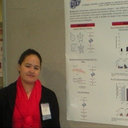About
23
Publications
3,593
Reads
How we measure 'reads'
A 'read' is counted each time someone views a publication summary (such as the title, abstract, and list of authors), clicks on a figure, or views or downloads the full-text. Learn more
421
Citations
Publications
Publications (23)
Host factors that mediate Leishmania genetic exchange are not well defined. Here we demonstrate that natural IgM (IgMn)1–4 antibodies mediate parasite genetic exchange by inducing the transient formation of a spherical parasite clump that promotes parasite fusion and hybrid formation. We establish that IgMn from Leishmania-free animals binds to the...
Incidence of visceral leishmaniasis (VL) in the Indian subcontinent (ISC) has declined by more than 95% since initiation of the elimination program in 2005. As the ISC transitions to the post-elimination surveillance phase, an accurate measurement of human-vector contact is needed to assure long-term success. To develop this tool, we identified Pag...
Host factors mediating Leishmania genetic exchange are not well defined. Here, we demonstrate that IgM antibodies, but not IgG or IgA, facilitate parasite genetic hybridization in vitro and in vivo. IgM induces the gradual and transient formation of a structured Leishmania clump that releases viable parasites in a process essential for L. major and...
Saliva from mosquitoes contains vasodilators that antagonize vasoconstrictors produced at the bite site. Sialokinin is a vasodilator present in the saliva of Aedes aegypti. Here, we investigate its function and describe its mechanism of action during blood feeding. Sialokinin induces nitric oxide release similar to substance P. Sialokinin-KO mosqui...
Visceral leishmaniasis (VL) is a potentially deadly parasitic disease. In the Indian sub-continent, VL is caused by Leishmania donovani and transmitted via the bite of an infected Phlebotomus argentipes female sand fly, the only competent vector species in the region. The highest disease burden is in the northern part of the Indian sub-continent, e...
Hematophagous vectors lacerate host skin and capillaries to acquire a blood meal, resulting in leakage of red blood cells (RBCs) and inflammation. Here, we show that heme oxygenase-1 (HO-1), a pleiotropic cytoprotective isoenzyme that mitigates heme-mediated tissue damage, is induced after bites of sand flies, mosquitoes, and ticks. Further, we dem...
Leishmania major is the causative agent of cutaneous leishmaniasis (CL). No human vaccine is available for CL and current drug regimens present several drawbacks such as emerging resistance, severe toxicity, medium effectiveness, and/or high cost. Thus, the need for better treatment options against CL is a priority. In the present study, we validat...
Chagas disease (ChD), caused by the hemoflagellate parasite Trypanosoma cruzi, affects six to seven million people in Latin America. Lately, it has become an emerging public health concern in nonendemic regions such as North America and Europe. There is no prophylactic or therapeutic vaccine as yet, and current chemotherapy is rather toxic and has...
Chagas disease (ChD), caused by the protozoan parasite Trypanosoma cruzi, affects millions of people worldwide. Chemotherapy is restricted to two drugs, which are partially effective and may cause severe side effects, leading to cessation of treatment in a significant number of patients. Currently, there are no biomarkers to assess therapeutic effi...
Leishmania major (L. major) is a protozoan parasite that causes cutaneous leishmaniasis. About 12 million people are currently infected with an annual incidence of 1.3 million cases. The purpose of this study was to synthesize a small library of novel thiophene derivatives, and evaluate its parasitic activity, and potential mechanism of action (MOA...
Background:
Protozoan parasites from the genus Leishmania cause broad clinical manifestations known as leishmaniases, which affect millions of people worldwide. Cutaneous leishmaniasis (CL), caused by L. major, is one the most common forms of the disease in the Old World. There is no preventive or therapeutic human vaccine available for L. major C...
Levels of IL-6 and IL-17 in the mouse sera following immunization with NGP5B or NGP5B+CpG.
IL-6 and IL-17 were analyzed in the sera of immunized mice three weeks after last immunization (B3), prior to challenge with L. major-luc (day 0, Fig 4A), as described in Materials and Methods. No significant difference was observed between NGP5B or NGP5B+CpG...
In previous studies we reported a novel series of organometallic compounds, RuII complexed with clotrimazole, displaying potent trypanosomatid activity with unnoticeable toxicity toward normal mammalian cells. In view of the promising activity of Ru-clotrimazole complexes against Leishmania major (L. major), the present work sought to investigate t...
Leishmania major (L. major) is a protozoan parasite causal agent of Leishmaniasis. It is estimated that 12 million people are currently infected and around 2 million infections occur each year. Current treatments suffer of high toxicity for the patient, low efficacy toward the parasite, high cost, and are losing effectiveness due to parasite resist...
In this study we assessed the antileishmanial activity of 126 α,β-unsaturated ketones. The compounds NC901, NC884, and NC2459 showed high leishmanicidal activity for both the extracellular (EC50 = 456 nM, 1122 nM, and 20 nM, respectively), and intracellular forms of Leishmania major propagated in macrophages (EC50 = 1870 nM, 937 nM, and 625 nM, res...
In our ongoing search for new metal-based chemotherapeutic agents against leishmaniasis and Chagas disease, six new ruthenium-ketoconazole (KTZ) complexes have been synthesized and characterized, including two octahedral coordination complexes-cis,fac-[Ru(II)Cl2(DMSO)3(KTZ)] (1) and cis-[Ru(II)Cl2(bipy)(DMSO)(KTZ)] (2) (where DMSO is dimethyl sulfo...
Currently, only one drug is available for the treatment of Leishmaniasis. For this reason, there is an urgent need to improve the chemotherapeutic methods against Leishmaniasis. Azoles derivatives such as clotrimazole (CTZ) have been found to exert their therapeutic effect through a mechanism involving the inhibition of the biosynthesis of sterols...
Eight new ruthenium complexes of clotrimazole (CTZ) with high antiparasitic activity have been synthesized, cis,fac-[Ru(II)Cl(2)(DMSO)(3)(CTZ)] (1), cis,cis,trans-[Ru(II)Cl(2)(DMSO)(2)(CTZ)(2)] (2), Na[Ru(III)Cl(4)(DMSO)(CTZ)] (3), Na[trans-Ru(III)Cl(4)(CTZ)(2)] (4), [Ru(II)(η(6)-p-cymene)Cl(2)(CTZ)] (5), [Ru(II)(η(6)-p-cymene)(bipy)(CTZ)][BF(4)](2...













































































